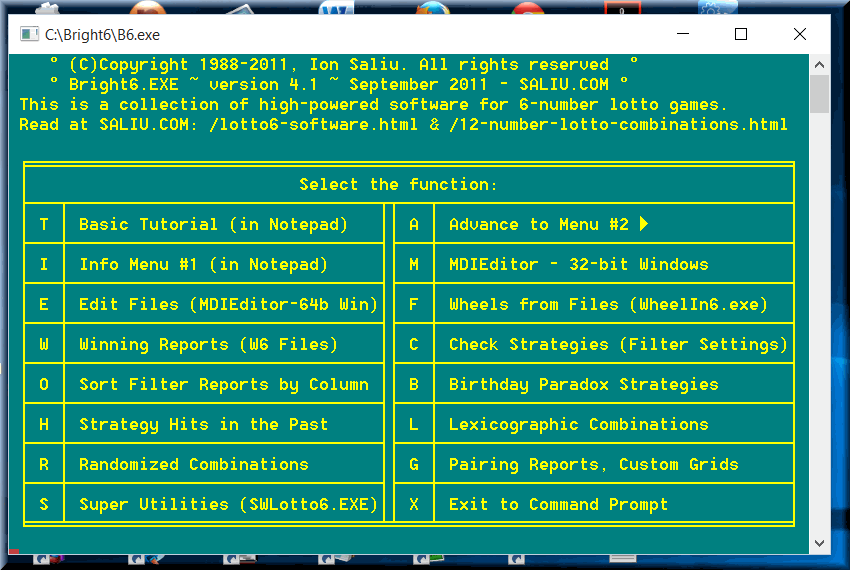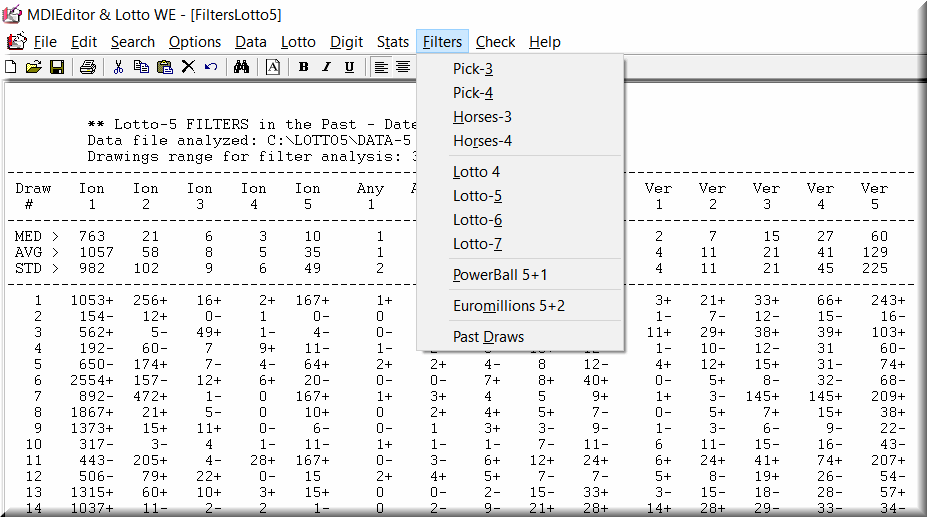
The Best Lottery Strategies: Foundation, Application of the Lotto Strategy Concept
By Ion Saliu, ★ Founder of Lotto Mathematics, Lottery Strategy Science



After all, I coined the term lottery strategy as I created the first lotto software programs in the 1980s. Look, I am not here to brag and I am not here to play false modesty either (i.e. hide behind my fingers). In my book, false modesty is as bad as lying. The truth is above anybody and anything.
Lottery strategies are sometimes interchanged with lotto systems. I do not consider the two terms as synonyms. For total correctness, I refer to lottery systems as abbreviated lotto systems or lotto wheels. The lottery strategy is a whole lot more comprehensive concept.
First, I created the concept of filters and filtering in lottery software. I came up with the term filter by accident. One morning I ran out of coffee filters. I realized how important those devices were. And that's how I came to name filters: Reduction parameters, eliminating restrictions in lotto software. Simply put it, the restrictions eliminate lottery combinations or reduce the amount of combinations (tickets) to play — while maintaining a high degree of certainty to win. In other words, we have a high level of confidence that the filters discard of unwanted, unnecessary combinations, outcome that will not hit the winner anyway.
The theory and application of filters in my computer programs are presented in grand detail on this specialized Web page: Filters, Filtering, Reduction Strategies in Lottery Software. If you haven't already, I strongly encourage you to read that material as the lottery strategies are based on filters.
Here is an example of a simple lottery strategy based on one filter/restriction: Generate lotto combinations that do not repeat any past drawing that hit the jackpot. It was the very first strategy I implemented in my first lotto programs. It might take a lifetime or three to witness a repeat of 6-number groups from past draws in 6-number jackpot lotto games! Evidently, that singular filter is not sufficient, albeit beneficial. More filters are necessary in order to cut down the huge amounts of possible combinations!
The nature of the filters determines the type of a lottery strategy. There two types of lottery restrictions or eliminating conditions:
I created the dynamic filters. They are at the foundation of my software and present only in my programs. Several developers tried to implement dynamic filters in their software, but without success. They don't know how I built my filters. In the 1990s-early 2000s, I was bombarded with requests to reveal the algorithms that create the dynamic lottery filters in my software.
And thusly, the rest of the lottery software developers only apply the static filters in their applications. These are the most common static filters, also treated on this site:
There are serious drawbacks related to the static filters. Firstly, they always generate a fixed (the same) amount of combinations for the same setting. For example 3 odd + 3 even in a 6/49 lotto game always amounts to 4,655,200 combinations (way too many to be played!) Secondly, the static filters are very streaky. I did find usefulness in the drawbacks of the static filters, however. Paradoxical? Yes. In fact, it is the nature of a very distinct strategy: reversed lottery strategy. Since the static filters are very streaky, I know with a high degree of certainty that they will not hit the very next drawing. Therefore I eliminate from play all the combinations they generate.
The core of my lottery software consists of applications targeting the creation and employment of dynamic strategies. This field is huge and comprises dozens of Web pages and software titles. You haven't seen anything more comprehensive in this domain — lottery software, strategies, systems — ever.
I devised many, many dynamic filters. I lost count how many dynamic filters I created — I made also several changes. All filters were proprietary first. Later, I revealed how some filters are built and work. You already met such a filter: Eliminate combinations drawn in the past — all of them or only the last (most recent) so-many drawings.
The software also allows the users to create their own lottery strategies by selecting what filters to enable. The user sets the filters at desired levels and saves the settings to specific text files. Or, the users can type the filter values on screen prompts presented by the programs. Then, a user can check how his/her specific strategy fared in the past by back-testing it against previous lotery drawings. Furthermore, the user can see how many combinations the specific strategy generated in the hit (winning) situations (draws). The two functions (C, H) are usually on the main menu of the specialized lottery apps:

The user needs to generate the filter reports, first and foremost. The very first filters in my lottery software, most of them proprietary, appear also on the main menu. The function is W = Winning Reports. The report files have W in the names; e.g. W6.1 for the first report in a 6-number lotto game. You can peek at a filter/winning report file named W3.1 (pick-3 digit game): Create Pick Lottery Strategies from Restriction Reports.
The user looks at the reports and selects filter values as specified on that very important aforementioned page. I refer to it again, given its importance: Filters, Filtering, Reduction Strategies in Lottery Software. My famed grand lottery application — MDIEditor Lotto WE — has a menu button that generates the filter reports: Filters.

It is the user who selects the filters and thusly building the strategies. The software cannot do it at this time in history. The computers cannot handle such a monumental task, even if a big team of the most skilled programmers would ever be able to write the application. At this time, I am unable to even tell how many lottery strategies are possible with my software. But I try my best to list here all possible categories of lottery strategies that my software creates and runs.
I conceived many more skip strategies while developing more potent software applications covering virtually all lottery games (plus horse racing, roulette, sports betting). One could write a book on the topic, including a mathematical treatise. For now, you can read comprehensive ebooks I authored:
The apps that create effective skip systems are also excellent combination generators, including from positional strings of numbers.
I conceived a better tactic to apply number frequencies for a profit. In fact, I will show you as a real-life example a lottery frequency strategy. It works in any pick-4 digit game in the world and is expandable to any type of lottery games. My method divides the lottery numbers in 3 groups based on frequencies. The most frequent numbers weigh more heavily: They form the smallest groups of numbers. The coldest numbers are placed in the largest group.
This is a very effective tactic in lottery. It is a powerful ally of all strategies that generate combinations that are expected to win — every strategy just presented here. On the other hand, every strategy presented here can also act as LIE Elimination. You will notices that groups of filters in the same type of software will not repeat soon. Therefore, we put together a number of filters from recent drawings that we know almost as factually that they will not hit the very next draw.
The combination generators have distinct functions performing the LIE Elimination feature. The user needs first to generate all LIE files, then combine them in one big file containing all combinations to be LIE-eliminated. The concatenation process of all files is automated to a high degree of functionality.
A single strategy can generate too many combinations. We can reduce the amount by purging the first output (let's call it pivot output) in other programs. We only need to synchronize the strategy files in the latter programs based on the pivot strategy file. I made the process easy to apply by writing special software: FileLines.
My focus was on the frequency report. The pick 4 digits are divided into 3 groups based on frequency (stats). The hottest group consists the 2 most frequent digits; next group has 3 digits; the least frequent group consists of 5 digits. I sorted the report by column to discern strategies more easily. I noticed a very interesting statistical phenomenon. We have two distinct frequency groups (1-3-0 and 2-2-0), both generating the same amount of pick-4 straight sets: 216. But the group with more digits in the most frequent group (2-2-0) registered 24 hits. The group with only one digit in the primary frequency group (1-3-0) recorded only 16 hits. The 2-2-0 configuration shows a 50% advantage.
Thus, there are 216 pick-4 straight sets to play. Of course, no strategy hits every drawing. There are skips between hits (wins). This particular lottery strategy had a skip median equal to 27. The strategy had numerous wins in 2016, when I monitored (tested) it.
Enters the second phase: Apply the reversed lottery strategy (LIE Elimination). The 216 combinations generated in the first phase are further reduced by applying the reversed elimination. There are very many possibilities there. The static filters are the best candidates to participate in the reversed reduction tactic. Also, the outcome of Markov Chains will not hit immediately (the very next drawing). The same is true about the skip systems, or systems playing the hottest half numbers in the game (generated by the FrequencyRank programs, also on menu II). The values of the skips in this module (SkipDecaFreq) do not repeat in bunch of 4, or even 3. Again, there are many possibilities to safely apply this potent strategy-in-reverse. There is valuable information on the pages I refer to here. You need to dedicate some time to studying and learning this extraordinary matter.
Suffice to say, I generated all winning reports in the modules that have reporting on their menus. Length of each report: 1000 past drawings (it might include simulated ones, it's OK).
Please study thoroughly the following ebook — it undoubtedly is worth your while.

Software Home Live Sports Blackjack Roulette Baccarat Craps Sports Sic Bo Artificial Intelligence
